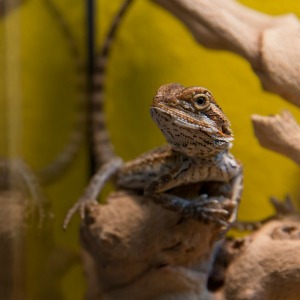
Before buying a pet, it's imperative that the prospective owner evaluate care, longevity, needs, and cost. Reptiles are appealing and popular pets, but often their needs are underestimated. The precautious buyer may be aware of these needs, but may be turned away from the overall cost of the animal's care. While it's good to evaluate overall lifetime costs, keep in mind that there are ways to own a lizard for less.
While the animal itself should come from a reliable location, the supplies are the same no matter where you find them. Pet stores target a specific audience and ask that audience to pay deeply for its items. Shop around for your items to find them cheaper.
Your cheapest place to find reptilian setup supplies may very well be your local hardware store. Timers, thermometers, light cones, and even humidity devices can be found at the home improvement store for a bottom price. When measured up to the brands offered at pet shops they compare equally. For items like shelving or aquarium displays, look at office supply stores or other furniture outlets and think creatively.
In 2011 Americans spent more than $50 billion on their pets, an all time high. While employees at pet stores may intend to help you, they often recommend what they are trained to recommend. Employees are notoriously known to push expensive light bulbs and heated rocks onto new owners. These products are not only expensively unnecessary but dangerous to certain types of reptiles. Instead, arm yourself with knowledge before entering the store, politely thank the associates for their help, and dismiss their advice.
Even those salespeople who own multiple reptiles may not be caring for their reptiles correctly. Instead, rely on those who have successfully raised reptiles or veterinarians and breeders.
Plastic plants can cost as much as $16 each. Make your own with sphagnum moss, wood from your yard, and sections of plastic decorative plants. Glue them together with silicone glue used for aquariums. To avoid the assembly and a bit of the cost, add driftwood or other wooden pieces from your yard to decorate the tank. Flat rocks can be glued together with the silicone glue to create caves, climbs, or other elements. Always glue rocks so that the items in your tank are stable, and boil the items for a few minutes to disinfect them. Never use pine or cedar in your vivarium.
When purchasing your initial aquarium, consider finding a wooden domicile for your new friend, especially if he requires high heat. The wooden frame will hold heat better than a glass enclosure. They're not plentiful, but they are available.
This page contains the following solutions.
When keeping lizards, they need a lot of heat, light, and a lot of space. You should feed them every night: crickets, meal worms, woodies; blue tongues love snails.
Here are the questions asked by community members. Read on to see the answers provided by the ThriftyFun community.
Has anyone built a large cage/house for a large lizard? We have a water dragon, and it apparently needs a cage about 6 feet wide and 4-5 feet high. My son wants to build one as a homeschooling project and we are looking for plans.
Hello,
I don't know if it would be big enough for you....but my uncle built a large cage for his iguana out of an old kitchen cabinet. He painted the the whole cabinet white and the inside green to look like leaves. It has a half shelf that the Sunny the iguana can climb on at the back of the cage. He installed a light in the top to keep Sunny warm and put screens on the doors with removable plexie glass.
i use a reptarium, there about a hundred dollars if youve got the money and a lot easier. they are 6ft by 3 ft square.
wow the cabinet sounds like a really cool idea too, i would hqave never thought of that, its perfect, i guess you just need to look in the local ads for used kitchen cabinets
I have heard of people using a shower stall with glass doors for water dragons. They had a hose from the drain into their basement drain so all they had to do was hose it down to clean it...and water dragons like humidity, so it was all good.
My daughter and I took 2 china cabinets and turned them into a huge bunny hutch. My son and I are getting ready to convert something (not sure what he will pick out yet!) for a large iguana cage. Converting things into cages for the kids pets gives us alot of together time and a piece they can take pride in knowing they helped design and build it. Good luck.
i am a homeschooling student as well and am building an outdoor cage for my 4 bearded dragons. it is split into 3 sections for obvious reasons but you can split yours however you like. the image attached are the plans for a cage. it is 6x4 and 3 feet tall. the whole enclosure is 4.5 feet tall.

Should I use sand for my gecko? Some say it's dangerous.
By Bree from Lancaster, PA
Sand can be ingested when the gecko eats and could cause impaction. A few people might say that you can use calcium sand, which is altogether different than sand, but it has also been known to cause impaction problems.
I am thinking about getting my first pet lizard but am unsure of which lizard to choose. I would like to keep at least two in the same tank and I have a 90x45x60 cm terrarium. I was wondering if you could recommend a suitable lizard that is easy to care for and can be handled.
By Darren
We have an iguana. He eats pellets sold in the pet food store, and fruit. He needs a special light to help his body produce calcium for strong bones, but other than that, he is very easy to care for. They poop in water, so he has a bath in the tub every day. He loves swimming and I take him out after he poops. He struts through the house, chasing the cats out of his way and likes to sunbathe in the livingroom window. He likes to ride on people's shoulders. We have had him since he was just 8 inches long, and he is now over 7 feet long. He bobs his head to greet us and comes to meet us when we get home. He has a huge "cage" (a metal enclosure with special lights on top) in the corner of the livingroom and likes to eat from people's fingers. He also likes to drink from my hand when I cup it under running water in the sink. Lenny is a really cool pet. There are lots of books on iguanas to research. I like the fact that he is a vegetarian and I don't have to feed him crickets and mice!